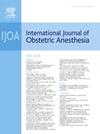Development and validation of a multivariable model for predicting prolonged length of stay following caesarean delivery
IF 2.3
3区 医学
Q2 ANESTHESIOLOGY
引用次数: 0
Abstract
Background
Postpartum length of stay is an important metric of recovery following delivery. Predicting prolonged hospital stay could be useful for postpartum care, facilitate patient counselling, allow targeted interventions for modifiable risk factors and support management of maternal bed capacity. Our aim was to develop and internally validate a predictive model for prolonged length of postpartum stay (≥90th percentile) following caesarean delivery (CD), with the secondary aim to elucidate factors influencing postpartum length of stay.
Methods
Following ethics approval in 107 centres in the UK, we conducted a prospective, multicentre study. Eligible patients were enrolled and baseline demographic, anaesthetic, obstetric and medical data were collected on day 1 postpartum and followed by telephone between day 28 and 32 postpartum, with data on length of stay, patient reported outcome measures, recovery, complications and readmission to hospital.
Results
Data from 1164 patients who underwent CD were included. A total of 119 patients had a prolonged (≥90th centile) length of stay (≥102 hours). The receiver operator characteristic curve for a prolonged length of stay under a lasso regularised logistic regression model had an area under the curve of 0.7808, with Obstetric Quality of Recovery (ObsQoR) score, neonatal intensive care admission, gestational age and urgency of CD the most important variables.
Conclusion
Using prospectively collected data from a large and diverse national cohort, we developed and validated a model to predict prolonged length of stay following CD in the UK. Further studies are required to determine if targeted interventions can help reduce prolonged length of stay.
预测剖宫产后住院时间延长的多变量模型的建立和验证
产后住院时间是衡量产后恢复的重要指标。预测住院时间延长可能有助于产后护理,促进患者咨询,允许针对可改变的风险因素采取有针对性的干预措施,并支持管理产妇病床容量。我们的目的是建立并内部验证一个预测剖宫产(CD)后延长产后住院时间(≥90百分位)的模型,第二个目的是阐明影响产后住院时间的因素。方法:在英国107个中心的伦理批准后,我们进行了一项前瞻性的多中心研究。纳入了符合条件的患者,并在产后第1天收集了基线人口统计学、麻醉、产科和医疗数据,并在产后28至32天之间进行了电话随访,收集了住院时间、患者报告的结果测量、康复、并发症和再入院的数据。结果纳入了1164例CD患者的数据。共有119例患者延长(≥90百分位)住院时间(≥102小时)。套索正则化logistic回归模型下延长住院时间的接受者特征曲线的曲线下面积为0.7808,产科康复质量(ObsQoR)评分、新生儿重症监护入院、胎龄和CD急迫性是最重要的变量。通过前瞻性地收集来自大量不同国家队列的数据,我们开发并验证了一个模型来预测英国CD患者的住院时间。需要进一步的研究来确定有针对性的干预措施是否有助于缩短住院时间。
本文章由计算机程序翻译,如有差异,请以英文原文为准。
求助全文
约1分钟内获得全文
求助全文
来源期刊
CiteScore
4.70
自引率
7.10%
发文量
285
审稿时长
58 days
期刊介绍:
The International Journal of Obstetric Anesthesia is the only journal publishing original articles devoted exclusively to obstetric anesthesia and bringing together all three of its principal components; anesthesia care for operative delivery and the perioperative period, pain relief in labour and care of the critically ill obstetric patient.
• Original research (both clinical and laboratory), short reports and case reports will be considered.
• The journal also publishes invited review articles and debates on topical and controversial subjects in the area of obstetric anesthesia.
• Articles on related topics such as perinatal physiology and pharmacology and all subjects of importance to obstetric anaesthetists/anesthesiologists are also welcome.
The journal is peer-reviewed by international experts. Scholarship is stressed to include the focus on discovery, application of knowledge across fields, and informing the medical community. Through the peer-review process, we hope to attest to the quality of scholarships and guide the Journal to extend and transform knowledge in this important and expanding area.

 求助内容:
求助内容: 应助结果提醒方式:
应助结果提醒方式:


